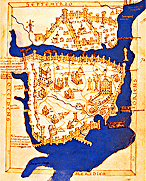 |
|
 |
General introduction
 n order to understand a historical period, it is important to record and interpret the events that proved to be very important and decisively
n order to understand a historical period, it is important to record and interpret the events that proved to be very important and decisively
 influential to its historical evolution. The internal and external developments within the Byzantine state, as well as the policy of Byzantine emperors over this period, are narrated in the chapter about the political history of the Late Byzantine Period. influential to its historical evolution. The internal and external developments within the Byzantine state, as well as the policy of Byzantine emperors over this period, are narrated in the chapter about the political history of the Late Byzantine Period.
The chronological limits as regards the division of Byzantine history into periods, are conventional according to the general opinion. Many historians claim that the beginning of the Late Byzantine Period was set in the 11th century, when radical changes happened in the internal zone of the Empire (administration, justice, economy, army) as well as in the territorial status quo. In spite of all that, the year 1204 was chosen to be the beginning of the Late Byzantine period, when probably the most important event for the Empire occurred. Constantinople, the centre of the Empire, was lost for the Byzantine people for the first time, and the Byzantine Empire was conquered by Latin crusaders and would be replaced by a new Latin one, for 57 years. In addition, the period of Latin occupation decisively influenced the Empire's internal development, as new elements of feudality entered all aspects of Byzantine life. After the gradual weakening of the structures of the Byzantine state and the reduction of its land due to Turkish invasions, came the fall of the Byzantine Empire, at the hands of the Ottomans, in 1453, when the Byzantine period is considered to have ended.
|